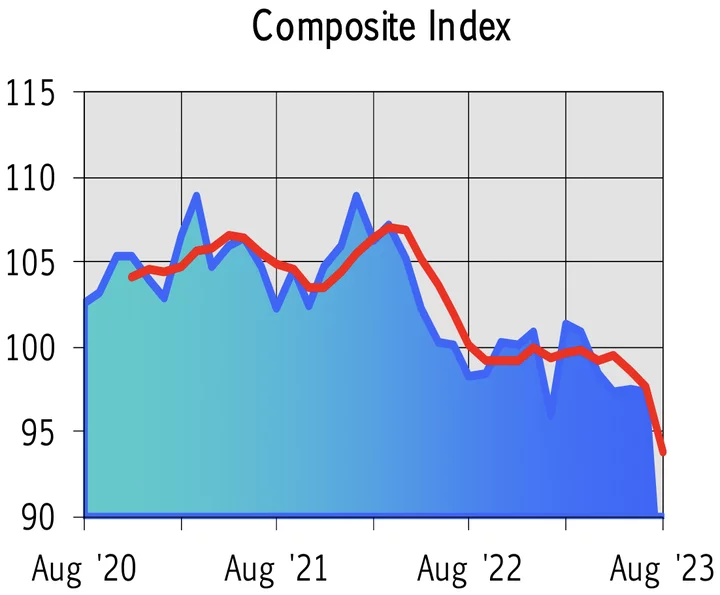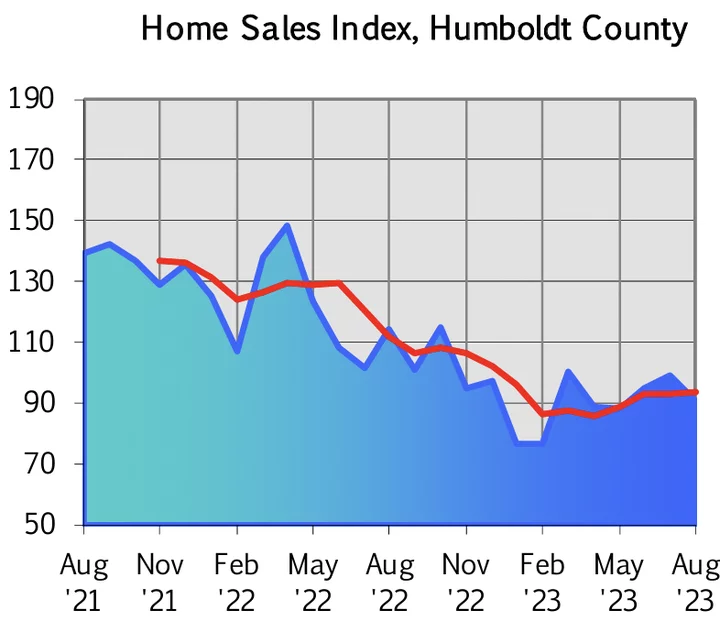The latest issue of the Humboldt Economic Index, a report produced by the Economics Department at Cal Poly Humboldt, shows a steep decline over the past year and a half or so. | Image courtesy Cal Poly Humboldt.
###
Humboldt County’s economy has seen some ups and downs since the beginning of 2021, but the overall trajectory over that timespan has been starkly downward, as shown in the latest Economic Index report [pdf] from Cal Poly Humboldt’s Economics Department.
The September report, which compiles data from multiple sectors of the economy, including home and retail sales, employment, electricity usage and hospitality, shows that the composite index fell 3.9 percent from the previous month and is down nearly eight percent from its mark five years ago.
Buffeted by nationwide headwinds, including rising interest rates, the end of COVID pandemic relief funding and 30 straight months of inflation, the local economy has faltered on several fronts.
For example, the county’s preliminary unemployment rate for September is 4.5 percent, up a full percentage point from the same time last year, according to data provided by the local office of the state’s Employment Development Department.
“One of the big headwinds is housing,” said Cal Poly Professor and Economics Department Chair Erick Eschker. Pointing to the data, he observed that after a slump during the worst of the pandemic, the county’s housing market came “back with a vengeance,” reaching records sales numbers toward the end of 2020 and into 2021.
While home prices have remained relatively high, the local housing market has been just “lukewarm,” which Eschker attributed largely to higher interest rates.
Home sales have fallen since reaching record sales numbers in 2021. | Image via Humboldt Economic Index.
###
Local Realtor Jill Macdonald said that while local housing sales have certainly cooled off from their white-hot peak in 2021, she believes the market is still healthy.
“Houses are still selling,” she said in a phone interview. In fact, in some ways she thinks the market is in better shape. “People aren’t having to pay $100,000 over asking [price], give their firstborn and release all contingencies. In that regard it’s a healthier market.”
Macdonald acknowledged that higher interest rates have slowed sales but said it would be unrealistic to expect rates to remain in the two to three percent range.
”So there has been some psychological recalibration,” she said. “People are getting used to the fact that seven percent, it’s not unheard of, but it also lessens [potential buyers’] ability to get into a property. It’s definitely harder; buying power has decreased. But that’s not a Humboldt County problem; it’s a nation problem.”
Scott Adair, the county’s economic development director, said the local retail and restaurant sectors have been particularly hard hit in recent months, and niche manufacturers have seen a decline in sales as consumers struggle to cover the increased costs of transportation, food, medical care and other essentials.
“We think that, to a great extent, what we’re beginning to experience are the more long-lasting after-effects of the pandemic,” Adair said. “We’ve talked to businesses who’ve shared that they’re not fully recovered from the emergency capital reserves expended during the pandemic.”
Plus, he said, the relief period for repaying federal emergency loans has expired.
“Consumers are paring down on what they’re willing to spend their income on,” Adair said. “We’re hearing from employers that they’re facing pressures to increase wages and salaries, and the concern is the cyclical effect of [businesses] then passing those costs back to consumers, which is hard for them to bear when they’re already feeling the pinch at home.”
Sales tax revenues for the unincorporated parts of the county have dropped steeply over the past two years. According to data provided by the county, annual sales tax revenues for the 2022-23 fiscal year were down 27 percent from the prior year and more than 35 percent from the year before that. That represents a loss of $2,664,832 from county government coffers and a significantly larger decline in receipts from local retailers.
The cities of Arcata and Fortuna have also seen declining sales tax revenues, which reflects difficult business conditions but also has an impact on the public sector.
“I think it is really important for the community to understand how changes in sales tax affect the budgets of small cities and our ability to provide services,” Fortuna City Manager Merritt Perry said in an email.
Still, not all the financial news is negative. Adair said the area has seen an influx of “climate refugees” and “equity refugees” as people move to Humboldt to escape the rising risks of natural disasters like extreme heat and wildfires or the rising costs of living in the Bay Area and Southern California.
“Also, the pandemic prompted this renaissance of interest in rural living and a slower way of life as people seek to get out of densely populated areas, which is why housing inventory been low and houses move very quickly,” Adair said. “We still hear stories of homes being sold sight-unseen from families trying to escape urban population centers.”
Adair noted that, like many rural areas, Humboldt can display a xenophobic streak, with a tendency to look down its nose at anyone whose family history doesn’t trace its county residency back multiple generations. He thinks that instinct generally comes from a good place of “trying to convey love and passion and how vested they are in the community, but for someone from the outside it does feel a little exclusionary.”
When new residents come to Humboldt, he said, they’re investing their own talent and education, bringing all of their life experience. “That’s a bonus and a benefit, to capture that intellectual property,” Adair said.
The pending development of offshore wind also presents economic opportunities for the region, and Adair said there has been an increase in interest from outside companies exploring investment in Humboldt County.
“And it’s as a result of Humboldt County being on the map, if you will, because of the potential for large federal projects in our region,” Adair said. “We’ve been contacted by companies not directly related [to wind energy] but [that] are part of the supply chain or even ancillary industries … . If we can work to capture some of those, it can create more wealth and spur job creation.”


CLICK TO MANAGE